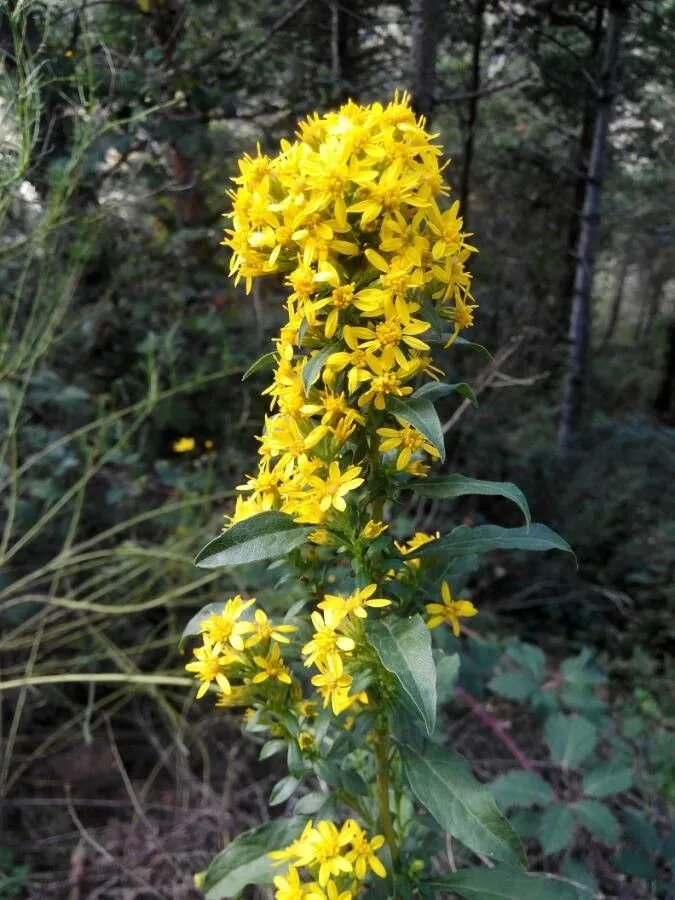
Author: L.
Bibliography: Sp. Pl.: 880 (1753)
Year: 1753
Status: accepted
Rank: species
Genus: Solidago
Vegetable: False
Observations: W. Europe to C. Siberia and Philippines (Luzon)
European goldenrod (Solidago virgaurea) is a perennial herb renowned for its striking yellow flowers that bring vibrant color to late-summer landscapes. This plant belongs to the Asteraceae family, which is known for its composite flower heads consisting of numerous small florets arranged in dense clusters.
The species Solidago virgaurea was first described in 1753 by the famous taxonomist Carl Linnaeus, as recorded in his seminal work “Species Plantarum.” It has since been a subject of interest for botanists and plant enthusiasts alike.
Geographically, European goldenrod displays a broad habitat range. It is native to Western Europe and extends its presence through Central Siberia, indicating its adaptability to various climatic conditions. Additionally, this plant has been observed as far as the Philippines, specifically on the island of Luzon.
The plant thrives in a variety of habitats including meadows, pastures, and forest clearings, often becoming a conspicuous component of late-season floral communities. Its bright yellow inflorescences not only add aesthetic value but also play a crucial role in supporting pollinators like bees and butterflies.
In terms of cultivation, Solidago virgaurea is appreciated both for its ornamental qualities and its ease of growth. It is relatively low-maintenance, requiring only well-drained soil and adequate sunlight. Given its wide natural range, it can tolerate a variety of soil types and climatic conditions, making it a versatile choice for gardeners and landscape designers.
Beyond its visual appeal, European goldenrod has also been recognized for its medicinal properties. Traditional medicine systems have utilized various parts of the plant for their purported therapeutic effects, particularly for treating ailments related to the urinary system.
Overall, the European goldenrod is a remarkable plant that brings both ecological value and medicinal utility. Its bright blooms are a testament to the diversity and resilience of the natural world, capturing the admiration of those who encounter it.
Dan: almindelig gyldenris
Eng: european goldenrod, goldenrod
Deu: gemeine goldrute, gewöhnliche goldrute, gewöhnliche goldrute i.w.s.
Nor: akeleje, guld-riis, gylden-riis, sougræs
Nld: echte guldenroede
Swe: gullris, kultapiisku
Nob: gullris
Nno: gullris
Fin: kultapiisku
Fra: solidage verge dor
Sme: beatnatnjuovčča, beatnatnjuvččarássi, beatnatrássi, beatnatsuoidni
Cym: cannwyll fair, eurwiail, eurwialen, eurwialen gyffredin, eurwialen melyneuraidd, gwialen aur, gwialen euraid, melyneuraid
En: European goldenrod, Goldenrod, Aaron’s Rod, Common Goldenrod, Golden Rod
Az: Qızılçubuq qızılsəbət
Be: Сумнік звычайны
Bg: Златен енчец
Ca: Vara d’or
Zh: 毛果一枝黄花
Kw: Owrwelen
Hr: Obična zlatnica
Cs: Zlatobýl obecný
Da: Almindelig Gyldenris
Nl: Echte guldenroede, Gewone Guldenroede
Et: Harilik kuldvits
Fi: Kultapiisku
Fr: Solidage verge dor, Solidage verge-d’or, Herbe des Juifs, Solidage verge d’or
Ka: Ოქროწკეპლა
De: Gewöhnliche Goldrute, Gemeine Goldrute, Gewöhnliche Goldrute i.w.S., Echte Goldrute
Hu: Közönséges aranyvessző
It: Verga d’oro comune, Verga-d’oro comune
Kk: Сары раушан
Lt: Paprastoji rykštenė
Mk: Златица (растение)
Se: Beatnatsuoidni, Beatnatnjuovčča, Beatnatnjuvččarássi, Beatnatrássi
No: Gullris, Akeleje, Guld-riis, Gylden-riis, Sougræs
Nb: Gullris
Nn: Gullris
Ps: اروپایي طلایي امسا
Fa: علف طلایی
Pl: Nawłoć pospolita
Ru: Золотарник обыкновенный
Sr: Златица
Sk: Zlatobyľ obyčajná, Zlatobyľ obrovská
Es: Navadna zlata rozga, Vara de oro, Vara de san José
Sv: Gullris, Kultapiisku
Zh-tw: 毛果一枝黃花
Tr: Altınbaşak (bitki)
Cy: Eurwialen, Cannwyll Fair, Eurwiail, Eurwialen Gyffredin, Eurwialen Melyneuraidd, Gwialen Aur, Gwialen Euraid, Melyneuraid
Taken Aug 11, 2019 by parramon marta (cc-by-sa)
Taken Oct 6, 2018 by Lise Pavelot (cc-by-sa)
Taken Aug 11, 2019 by parramon marta (cc-by-sa)
Taken Aug 11, 2019 by parramon marta (cc-by-sa)
Taken Oct 9, 2017 by Salvador Prat Oller (cc-by-sa)
Taken Jan 18, 2022 by Tristan Jaton-Maria (cc-by-sa)
Taken Nov 28, 2020 by Hélène (cc-by-sa)
Taken Sep 7, 2020 by Jean-René Girardeau (cc-by-sa)
Taken Aug 17, 2021 by Nathalie Potel (cc-by-sa)
Taken Oct 9, 2017 by Salvador Prat Oller (cc-by-sa)
Taken Sep 7, 2020 by Jean-René Girardeau (cc-by-sa)
Taken Aug 29, 2019 by Anne-laure Bauduin (cc-by-sa)
Taken Sep 22, 2019 by parramon marta (cc-by-sa)
Taken Jul 8, 2021 by margarida vila (cc-by-sa)
Taken Jul 8, 2021 by margarida vila (cc-by-sa)
Taken Nov 27, 2020 by Hélène (cc-by-sa)
Taken Jan 18, 2022 by Tristan Jaton-Maria (cc-by-sa)
Taken Sep 22, 2018 by Rod Robison (cc-by-sa)
Taken Jan 18, 2021 by Dieter Wagner (cc-by-sa)
Taken Jan 18, 2021 by Dieter Wagner (cc-by-sa)
Taken Aug 7, 2012 by Tela Botanica − Dominique REMAUD (cc-by-sa)
Taken Jul 7, 2011 by Tela Botanica − Jean Michel FOULETIER (cc-by-sa)
Taken Oct 3, 2019 by curritodelacroix (cc-by-sa)
Taken Aug 30, 2012 by Tela Botanica − Jean-Jacques HOUDRÉ (cc-by-sa)
Taken Oct 29, 2019 by Eduard (cc-by-sa)
Taken Sep 26, 2021 by Dieter Bausenwein (cc-by-sa)
Taken Sep 12, 2020 by Pires Marie-Elisabeth (cc-by-sa)
Taken Jul 22, 2019 by Rimsky Vadim (cc-by-sa)
Taken Sep 13, 2019 by Guido Steinke (cc-by-sa)
Taken Oct 29, 2019 by Eduard (cc-by-sa)
© copyright of the Board of Trustees of the Royal Botanic Gardens, Kew.
© copyright of the Board of Trustees of the Royal Botanic Gardens, Kew.
© copyright of the Board of Trustees of the Royal Botanic Gardens, Kew.
Ph maximum: 6.5
Ph minimum: 5.5
Light: 6
Atmospheric humidity: 4
Soil nutriments: 4
Family: Myrtaceae Author: (F.Muell.) K.D.Hill & L.A.S.Johnson Bibliography: Telopea 6: 402 (1995) Year: 1995 Status:…
Family: Rubiaceae Author: Pierre ex A.Froehner Bibliography: Notizbl. Bot. Gart. Berlin-Dahlem 1: 237 (1897) Year:…
Family: Sapindaceae Author: Koidz. Bibliography: J. Coll. Sci. Imp. Univ. Tokyo 32(1): 38 (1911) Year:…
Family: Asteraceae Author: A.Gray Bibliography: Pacif. Railr. Rep.: 107 (1857) Year: 1857 Status: accepted Rank:…
Family: Fabaceae Author: Medik. Bibliography: Vorles. Churpfälz. Phys.-Ökon. Ges. 2: 398 (1787) Year: 1787 Status:…
Family: Aspleniaceae Author: (Cav.) Alston Bibliography: Bull. Misc. Inform. Kew 1932: 309 (1932) Year: 1932…